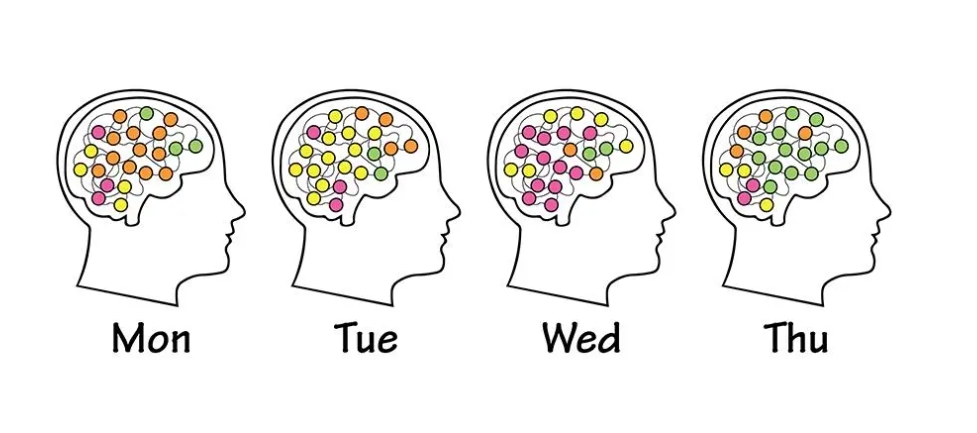Study shows how our brains remain active during familiar, repetitive tasks

一项基于小鼠早期研究的新研究表明,即使我们对周围的世界一无所知,我们的大脑也永远不会静止不动。
New research, based on earlier results in mice, suggests that our brains are never at rest, even when we are not learning anything about the world around us.
我们的大脑通常被比作计算机,其学习的技能和记忆存储在数十亿个神经细胞的活动模式中。但是,新的研究表明,对特定事件和经历的记忆可能永远不会平静下来。相反,即使我们没有学习任何新知识,存储信息的活动模式也可能会不断变化。
Our brains are often likened to computers, with learned skills and memories stored in the activity patterns of billions of nerve cells. However, new research shows that memories of specific events and experiences may never settle down. Instead, the activity patterns that store information can continually change, even when we are not learning anything new.
为什么这不会导致大脑忘记所学内容?一项来自剑桥大学,哈佛医学院和斯坦福大学的研究揭示了尽管代表大脑的大脑信号发生了巨大变化,但大脑如何能够可靠地访问存储的信息。
Why does this not cause the brain to forget what it has learned? The study, from the University of Cambridge, Harvard Medical School and Stanford University, reveals how the brain can reliably access stored information despite drastic changes in the brain signals that represent it.
由剑桥大学工程系的蒂莫西·奥利里博士领导的这项研究表明,大脑的不同部分可能需要重新学习并跟踪大脑其他部分的信息。他们的研究发表在开放存取期刊eLife上,其提供了一些初步证据,证明神经活动的不断变化与所学技能的长期记忆保持一致。
The research, led by Dr Timothy O’Leary from Cambridge’s Department of Engineering, shows that different parts of our brain may need to relearn and keep track of information in other parts of the brain as it moves around. Their study, published in the open-access journal eLife, provides some of the first evidence that constant changes in neural activity are compatible with long term memories of learned skills.
研究人员通过对实验数据进行建模和分析得出了这一结论,在该实验中,对小鼠进行了训练,使其将4.5米长的虚拟现实迷宫开始时的视觉提示与在T形结处向左或向右转相关联,在导航到奖励之前。这项2017年的研究结果表明,即使小鼠的行为随着时间的推移保持稳定,大脑中的单个神经细胞仍会不断改变其编码的有关这项学习到的任务信息。
The researchers came to this conclusion through modelling and analysis of data taken from an experiment in which mice were trained to associate a visual cue at the start of a 4.5-metre-long virtual reality maze with turning left or right at a T-junction, before navigating to a reward. The results of the 2017 study showed that single nerve cells in the brain continually changed the information they encoded about this learned task, even though the behaviour of the mice remained stable over time.
实验数据包括来自数百个神经细胞的活动模式,这些活动模式同时记录在控制和计划运动的大脑部分中,并且以人类尚不可能实现的分辨率记录。
The experimental data consisted of activity patterns from hundreds of nerve cells recorded simultaneously in a part of the brain that controls and plans movement, recorded at a resolution that is not yet possible in humans.
奥利里说:“在这种庞大的细胞集合中寻找连贯的模式非常具有挑战性,就像试图通过观察随机样本来确定昆虫群的行为一样。但是,在某些方面,大脑本身需要解决类似的任务,因为其他大脑区域需要从同一群体中提取和处理信息。”
“Finding coherent patterns in this large assembly of cells is challenging, much like trying to determine the behaviour of a swarm of insects by watching a random sample of individuals,” said O’Leary. “However, in some respects the brain itself needs to solve a similar task, because other brain areas need to extract and process information from this same population.”
神经细胞连接到数百甚至数千个邻居,并通过加权和合并来提取信息。这与民意测验在选举前所使用的方法非常相似:收集来自多个来源的调查结果,并根据其一致性对它们进行“加权”。这样,即使单个测量值发生巨大变化,也可以显示出稳定的模式。
Nerve cells connect to hundreds or even thousands of their neighbours and extract information by weighting and pooling it. This has a direct analogy with the methods used by pollsters in the run-up to an election: survey results from multiple sources are collected and ‘weighted’ according to their consistency. In this way, a steady pattern can emerge even when individual measurements vary wildly.
剑桥小组使用此原理构造了一种解码算法,该算法在数百个细胞的复杂活动中提取出一致的隐藏模式。他们发现了两个现象。首先,确实存在一个一致的隐藏模式,可以准确预测动物的行为。其次,这种一致的模式本身会随着时间而逐渐变化,但是变化并没有大到解码算法无法跟上。这表明大脑不断修改内部代码,以在不同内部电路之间传递信息。
The Cambridge group used this principle to construct a decoding algorithm that extracted consistent, hidden patterns within the complex activity of hundreds of cells. They found two things. First, that there was indeed a consistent hidden pattern that could accurately predict the animal’s behaviour. Second, this consistent pattern itself gradually changes over time, but not so drastically that the decoding algorithm couldn’t keep up. This suggests that the brain continually modifies the internal code that relays information between different internal circuits.
科幻小说探索了将我们的记忆和经验直接从我们的大脑转移到硬件设备的可能性。如果未来的技术最终允许我们上传和下载我们的思想和记忆,那么我们可能会发现,如果多年后重播大脑,我们的大脑将无法解释其自身的活动模式。苹果的概念-其颜色,香味,味道和与之相关的记忆-可能保持一致,但随着时间的推移,它在大脑中引起的活动方式可能会完全改变。
Science fiction explores the possibility of transferring our memories and experiences into hardware devices directly from our brains. If future technology eventually allows us to upload and download our thoughts and memories, we may find that our brain cannot interpret its own activity patterns if they are replayed many years later. The concept of an apple - its colour, flavour, taste and the memories associated with it - may remain consistent, but the patterns of activity it evokes in the brain may change completely over time.
这项研究表明,这个难题在不久的将来可能依然无法解决,但是实现这种思维方式的有限版本的实验技术已经成为现实。脑机接口是一种快速成熟的技术,并且可以控制假肢和外部硬件的人类神经接口已经在临床上使用了十多年。剑桥小组的工作突显了从大脑提取可靠信息方面的主要公开挑战。
Such conundrums will likely remain speculative for the immediate future, but experimental technology that achieves a limited version of such mind reading is already a reality, as this study shows. Brain-machine interfaces are a rapidly maturing technology, and human neural interfaces that can control prosthetics and external hardware have been in clinical use for over a decade. The work from the Cambridge group highlights a major open challenge in extracting reliable information from the brain.
奥利里博士是剑桥大学信息工程和医学神经科学讲师,他说:“即使我们现在可以监视大脑活动并将其直接与记忆和经验联系起来,但活动模式本身会在几天内不断变化。我们的研究表明,尽管发生了这种变化,我们仍可以构建并维护一个相对稳定的'字典',以读出动物在熟悉的环境中的思维方式。
“Even though we can now monitor brain activity and relate it directly to memories and experiences, the activity patterns themselves continually change over a period of several days,” said O’Leary, who is a Lecturer in Information Engineering and Medical Neuroscience. “Our study shows that in spite of this change, we can construct and maintain a relatively stable ‘dictionary’ to read out what an animal is thinking as it navigates a familiar environment.
“这项工作表明,即使我们对外部世界一无所知,我们的大脑也永远不会静止不动。这对我们对大脑的理解以及对脑机接口和神经假体具有重要意义。”
“The work suggests that our brains are never at rest, even when we are not learning anything about the external world. This has major implications for our understanding of the brain and for brain-machine interfaces and neural prosthetics.”

 中文
中文 English
English
